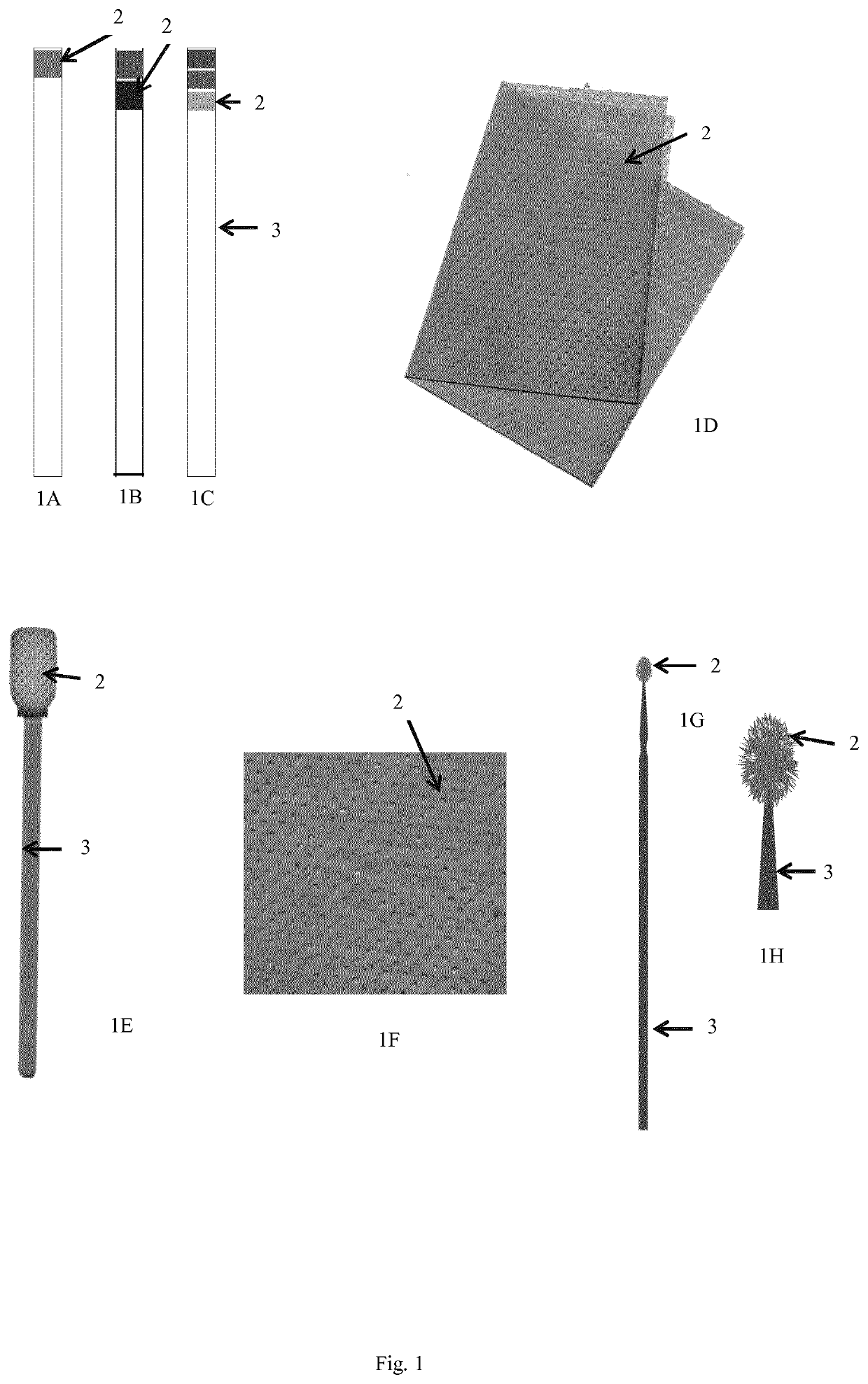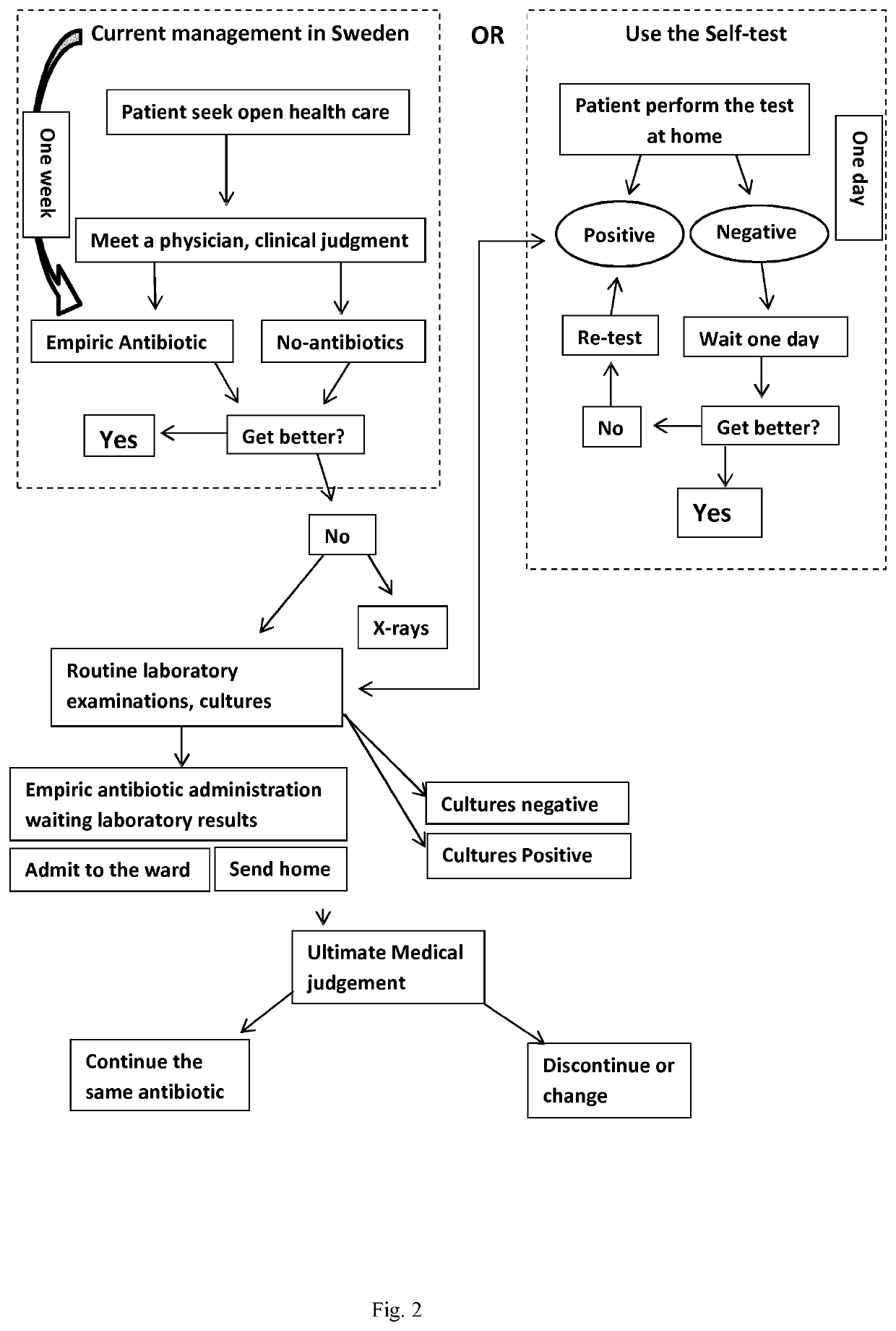Device and method for detecting a bacterial infection
a technology for detecting devices and bacteria, applied in the field of diagnostics, can solve problems such as a large reduction in social and individual costs and an objective antibiotic treatment strategy
- Summary
- Abstract
- Description
- Claims
- Application Information
AI Technical Summary
Benefits of technology
Problems solved by technology
Method used
Image
Examples
example 1
[0109]Clinical Performance Study of Dexact-Resp (a Device of the Present Disclosure) on Left-Over Sputum in Diagnosis of Bacterial Pneumonia
[0110]Background:
[0111]In patients with clinical symptoms of respiratory infection, rapid identification of cases requiring antibiotic therapy is crucial to avoid development of multiple resistant bacteria. Identification of local acute-phase reactants can help assess the host's response to bacterial infection at the injury site. Here we developed an affordable, stable, feasible, and accurate diagnostic tool based on a locally produced protein with specific binding affinity to polysaccharides. We further evaluated the ability of the novel test strip to detect bacterial infection in cases of pneumonia.
[0112]Methods
[0113]A strip test (the so called index test) was developed based on inverted metachromacy. Leftover sputum samples (n=467) from patients with suspected pneumonia were blindly tested using the index test (Table 4). These results were co...
example 2
[0121]Clinical Performance Study of Dexact-Urine on Left-Over Urine in Diagnosis of Urinary Tract Infection
[0122]The urine strip test could differentiate between cases of severe proximal urinary tract infection from uncomplicated distal urinary tract infection and healthy (Table 7).
TABLE 7Clinical performance study of Dexact urineDexact stripPercent DexactLeft-over urine collected atnegativepositive in bothUniversity Hospital in Linköping(1 surfacesurfaces thatSweden 29th April-9th may 2016positive) / bothindicates seriousCulture(1-97 years, median 64 year) andsurfacescases (sensitivityurineCRP >freshly analyzed (n = 538)positiveor specificity)positive20Abdominal disorder n = 3215(16) / 1 3%87Control of urine during brain3 + 7 / 0 030injuries N = 10Renal calculus uncomplicated n = 8 2(6) / 0020Complicated infections n = 123 + 3 / 6 50%49Control urine as a part of65 (38) / 6 5%110investigation n = 109Distal UTI n = 14771(66) / 10 6.8% (93%986specificity forexclusion ofnon-serious cases71 + 66 / 14...
example 3
[0124]Clinical Performance Study of Dexact-CSF on Patients with Nosocomial Bacterial Meningitis Included at the Department of Neurosurgery
[0125]Currently, the diagnosis of bacterial meningitis remains based on standard methods of direct microscopy, differential analyses of white blood cells, lactate, and protein, and cultures of blood and CSF [Baty V, 2000]. However, post-neurosurgical infections are difficult to distinguish from the effects of neurosurgical procedures [Baty V, 2008; Walti L N, 2013]. For example, when patients develop fever within days after surgery, a determination of cells and lactate in the CSF cannot provide reliable information. Moreover, due to prophylaxis treatments, the cultures are negative in a large group of patients, and the presence of skin flora, like Coagulase negative Staphylocococcus or Propionbacterium acnes, may indicate either infection or contamination.
[0126]Study on cerebrospinal fluid from cases that were admitted to the Department of Neurosu...
PUM
| Property | Measurement | Unit |
|---|---|---|
| colour | aaaaa | aaaaa |
| antimicrobial resistance | aaaaa | aaaaa |
| population density | aaaaa | aaaaa |
Abstract
Description
Claims
Application Information
 Login to View More
Login to View More - R&D
- Intellectual Property
- Life Sciences
- Materials
- Tech Scout
- Unparalleled Data Quality
- Higher Quality Content
- 60% Fewer Hallucinations
Browse by: Latest US Patents, China's latest patents, Technical Efficacy Thesaurus, Application Domain, Technology Topic, Popular Technical Reports.
© 2025 PatSnap. All rights reserved.Legal|Privacy policy|Modern Slavery Act Transparency Statement|Sitemap|About US| Contact US: help@patsnap.com


